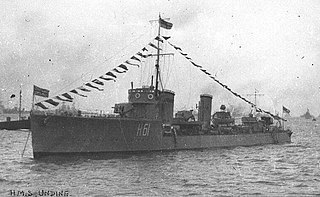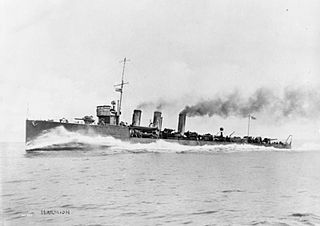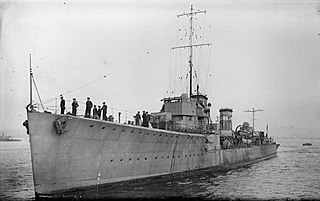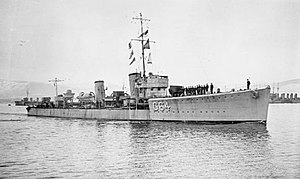
HMS Urchin was a Modified Admiralty R-class destroyer which served with the Royal Navy during the First World War. The Modified R class added attributes of the Yarrow Later M class to improve the capability of the ships to operate in bad weather. The destroyer was the third ship in the Navy to be named after the sea urchin and the first in the class to be built by Palmers in Jarrow. Launched in 1917, Urchin served with the Grand Fleet, seeing action in the Second Battle of Heligoland Bight. After the war, the destroyer was remained in service until being retired and sold to be broken up in 1930.

HMS Tobago was a Thornycroft S-class destroyer which served with the Royal Navy during the Greco-Turkish War. Launched by Thornycroft on 15 July 1918, the vessel followed a design typical of the yard by being faster than the majority of the class, and also had better seakeeping properties thanks to a raised forecastle. The destroyer operated as part of the Grand Fleet for the last few weeks of the First World War, and, after the Armistice, joined the Mediterranean Fleet based in Malta. While serving in off the coast of Turkey, the ship hit a mine on 15 July 1920, exactly two years after being launched. Despite the relative youth of the vessel, the damage was deemed irrepairable and so Tobago returned to Malta and was sold for scrap on 9 February 1922.

HMS Magic was an Admiralty M-class destroyer which served with the Royal Navy during the First World War. The M class were an improvement on the previous L class, capable of higher speed. Originally laid down as HMS Marigold by J. Samuel White at East Cowes on the Isle of Wight, the vessel was renamed before being launched in 1915. The ship served during the War as part of the Grand Fleet, mainly on anti-submarine and convoy escort duties from the port of Queenstown. In 1917, the destroyer took part in the Battle of Jutland and was one of a small number of British vessels that attacked the German fleet with torpedoes, although both torpedoes missed. In 1918, the ship struck a mine of the coast of Ireland and, although the damage was repaired, 25 people died. After the War, the destroyer was placed in reserve and decommissioned, being sold to be broken up in 1921.

HMS Medway was a Admiralty M-class destroyer which served with the Royal Navy during the First World War. The M class were an improvement on the previous Laforey-class, capable of higher speed. Originally laid down as HMS Redwing by J. Samuel White at East Cowes on the Isle of Wight, the vessel was renamed before being launched on 8 March 1916. The vessel was allocated to the Grand Fleet and served in the Second Battle of Heligoland Bight in support of the First Light Cruiser Squadron in their action against German light cruisers and minesweepers. During the action, the ship did not record any hits. After the War, the destroyer was placed in reserve and subsequently sold to be broken up on 9 May 1921.

HMS Plover was a Admiralty M-class destroyer which served with the Royal Navy during the First World War. The M class were an improvement on the previous L-class, capable of higher speed. Launched on 3 March 1916 by Hawthorn Leslie on the River Tyne, the vessel served as part of the Grand Fleet. Plover was based at Scapa Flow and took part in sorties in response to German submarine activity. After an uneventful war, the destroyer was placed in reserve and decommissioned, being sold to be broken up on 9 May 1921.

HMS Tara was an S-class destroyer, which served with the Royal Navy. Launched on 7 August 1918, the vessel entered service at the closing of the First World War. The ship joined the Fourteenth Destroyer Flotilla of the Grand Fleet but was placed in Reserve at Nore in 1919. Tara deteriorated over the following years and was sold to be broken up on 17 December 1931 after the signing of the London Naval Treaty that limited the amount of destroyer tonnage the Navy could retain.

HMS Serene was an S-class destroyer, which served with the Royal Navy. Launched on 30 November 1918 just after the end of the First World War, the ship was commissioned into the Reserve Fleet. Excluding a brief expedition to Latvia near to the end of that nation's War of Independence in 1919, the destroyer remained in reserve at Devonport until 1936. During this period, the condition of the destroyer deteriorated. Then, as part of a deal for the liner Majestic, Serene was sold to be broken up on 14 September.

HMS Trojan was an S-class destroyer, which served with the Royal Navy. The vessel was the only one named in honour of the citizens of Troy that has been operated by the navy. Launched on 12 July 1918, Trojan was too late to see service in the First World War. Initially allocated to the Grand Fleet and then, when this was dissolved, the Atlantic Fleet, the destroyer was transferred to the Reserve Fleet, like many of the class, within two years of being first commissioned. The vessel remained in reserve until 24 September 1936, although in a deteriorating condition. On that day, Trojan was sold to be broken up as part of a deal for the liner Majestic.

HMS Trinidad was an S-class destroyer that served with the Royal Navy. The ship was named after the island in the West Indies. Launched on 8 May 1918, the vessel entered service with the Grand Fleet but saw no action during the First World War. After the Armistice, Trinidad joined the Mediterranean Fleet. War had broken out between Greece and Turkey and there was intelligence that the Soviet Union was selling warships to one of the belligerents. Trinidad was part of a small flotilla that was sent to investigate and, ultimately, halt this trade. However, it turned out to be a hoax. The destroyer subsequently returned to Constantinople. In 1930, the signing of the London Naval Treaty required the Royal Navy to retire older destroyers before acquiring new ones. Trinidad was one of those chosen for retirement and, on 16 February 1932, the destroyer was sold to be broken up.

HMS Trusty was an S-class destroyer that served with the Royal Navy. The vessel was the third of the name. Launched in November 1918 just before the Armistice that ended the First World War, Trusty joined the Home Fleet the following year. However, the destroyer did remain in service long and was transferred to the Reserve Fleet in 1920. The vessel remained in reserve until 25 September 1936, although in a deteriorating condition. On that day, Trusty was sold to be broken up as part of a deal for the liner Majestic.

HMS Sepoy was an S-class destroyer, which served with the Royal Navy during the First World War and the Russian Civil War. Sepoy was launched in 1918 and initially joined the Grand Fleet. After the Armistice that ended the First World War, the ship was briefly transferred to the Reserve Fleet before sailing to Tallinn in 1919 as part of the Royal Navy response to the fighting there. Sepoy rejoined the Reserve Fleet at the end of the year. In 1922, the destroyer served in the Mediterranean Sea. The ship was later allocated to the naval base in Hong Kong, arriving in 1929. During exercises the following year, a depth charge explosion killed six sailors. The destroyer was also damaged. Following the signing of the London Naval Treaty a few days later, Sepoy returned to the United Kingdom and, in 1932, was sold to be broken up at Newport, Wales.

HMS Senator was an S-class destroyer, which served with the Royal Navy during the First World War, Greco-Turkish War and Russian Civil War. The S class were a development of the previous R class, and Senator was the first of six constructed by Denny. Senator was launched on 2 April 1918 and joined the Mediterranean Fleet. After the Armistice that ended the First World War, the destroyer continued to serve in active duty, both in the Mediterranean and the Black Seas. For example, in 1919, the ship helped cover the evacuation of Russian troops from Batumi. In 1925, Senator was placed in reserve and, in 1936, was given to Thos. W. Ward of Sheffield in part-exchange for the liner RMS Majestic.

HMS Seraph was an S-class destroyer, which served with the Royal Navy during the Russian Civil War. The S class were a development of the previous R class, with minor differences, constructed at the end of the First World War. Seraph had a career as an evacuation vessel more than as a warship. Launched in 1918 by Denny, Seraph was originally destined for the Grand Fleet but, after the Armistice, the destroyer transferred to the Mediterranean Fleet based at Malta. The destroyer was sent into the Black Sea to support the White Russian forces in their fight against the Communists. The role involved supporting the movement of troops rather than firing at the enemy. Ultimately, the Communists won and Seraph helped the evacuation of White Russian troops from Crimea, returning to Malta in 1921. The destroyer was then stationed in the Eastern Mediterranean in 1923 in response to the tensions in Turkey. In 1927, the ship was sent to Hong Kong to serve under the Commander-in-Chief, China. In 1929, the vessel was once again called to evacuate, this time Christian missionaries from the Chinese Red Army. Once again, the evacuation took place without bloodshed. With the introduction of more modern destroyers, the Royal Navy started retiring the S class and, in 1934, Seraph was sold to be broken up.

HMS Sesame was an S-class destroyer, which served with the Royal Navy in the twentieth century. Launched on 30 November 1918 just after the end of the First World War, the ship was commissioned into the Reserve Fleet. A year later, the destroyer was sent to Latvia in support of the country's call for independence, arriving just at the cessation of that county's war of independence. Returning to the United Kingdom, Sesame was later equipped to act as a plane guard within the Home Fleet, with all armament removed and a davit fitted to rescue aircraft. The vessel remained in that configuration for a short time, but the London Naval Treaty sounded the death knell for the ship as it limited the destroyer tonnage that the Royal Navy could operate. As newer and more powerful destroyers entered service, Sesame was one of those retired, being sold to be broken up on 4 May 1934.

HMS Northesk was an Admiralty M-class destroyer which served in the Royal Navy during the First World War. The M class was an improvement on the previous L-class destroyer, capable of higher speed. The vessel was launched in 1916 and joined the Grand Fleet. Northesk was involved in escorting convoys, including the first southbound convoy on the coastal route between Lerwick and Immingham in 1917. After the Armistice that marked the end of the First World War, the destroyer joined the Mediterranean Fleet and operated in the area around Sevastopol, including assisting in the evacuation of the Crimea in 1919. Soon afterwards, in 1921, Northesk was decommissioned and sold to be broken up.

HMS Seawolf was an S-class destroyer that served with the Royal Navy and, in 1922, was commanded by the future Admiral of the Fleet, John Tovey. Launched in 1918 just before the end of the First World War, the warship initially joined the torpedo school at Devonport before, in 1919, serving briefly in the Latvian War of Independence. Subsequently deployed to Ireland, the vessel carried some of the bodies of the victims of Bloody Sunday to their funerals in 1920 and, in 1924, rescued the passengers and crew of the steamship Asian that had sunk in a storm near Queenstown. After the London Naval Treaty of 1930 restricted the tonnage of destroyers operated by the Navy, Seawolf was retired and, in 1931, was sold to be broken up.

HMS Steadfast was an Admiralty S-class destroyer that served with the Royal Navy in the Russian Civil War. The S class was a development of the R class created during the First World War as a cheaper alternative to the V and W class. Launched in 1918 just before the Armistice, the ship was commissioned into the Mediterranean Fleet and was soon in action as part of the Royal Navy operation supporting the White Russians in the Black Sea. In 1919, Steadfast accompanied the monitor M29 in bombarding a Russian battery in Ochakiv and, the following year, took part in action north of the Georgian city of Poti alongside the light cruiser Caradoc. Soon afterwards, the destroyer returned to Chatham and was placed in reserve at Nore. Steadfast was retired and sold to be broken up in 1934.

HMS Sirdar was an Admiralty S-class destroyer that served with the Royal Navy during the Turkish War of Independence. The S class was a development of the R class created during the First World War as a cheaper alternative to the V and W class. Launched in 1918 just before the Armistice, the ship initially joined the Grand Fleet but was swiftly transferred to reserve when the war ended. After a short period based in Rosyth, the destroyer was transferred to the Mediterranean Fleet at the end of 1919 in time for the Turkish War of Independence. The vessel helped British and Ottoman forces defend the town of Izmit and to escort the Turkish battlecruiser Yavuz Sultan Selim to Tuzla. The destroyer was subsequently deployed to the China Station. Between 1927 and 1931, Sirdar was involved in combatting piracy, including helping the crew of the passenger ship Hatching defeat 25 pirates that had secreted themselves amongst the passengers. In 1930, the destroyer was fired on by members of the Chinese Red Army while cruising along the Yangtze. The signing of the London Naval Treaty that year meant that the Royal Navy needed to decommission older destroyers as new vessels entered service. In 1934, Sirdar was retired and sold to be broken up.

HMS Tintagel was an Admiralty S-class destroyer that served with the Royal Navy in the Second World War. The S class was a development of the R class created during the First World War as a cheaper alternative to the V and W class. Launched in 1918 shortly after the Armistice, the ship was commissioned into the Fourteenth Destroyer Flotilla of the Grand Fleet. However, the end of the war meant that destroyers were not needed in the front line to the same extent and Tintagel was recommissioned into the Reserve Fleet a year later. Between 1920 and 1921, the ship served with the torpedo school at Sheerness. In 1924, the vessel accompanied the submarine X1 on sea trials. After the London Naval Treaty of 1930, and the subsequent reduction in the Royal Navy's older destroyer force, Tintagel was retired and, in 1931, sold to be broken up in Plymouth.

HMS Stonehenge was an Admiralty S-class destroyer that served with the Royal Navy during the twentieth century. The S class was a development of the R class created during the First World War as a cheaper alternative to the V and W class. Launched after Armistice that ended the war, the ship was commissioned in 1919 and joined the Fourth Destroyer Flotilla. The vessel supported the Allied intervention in the Russian Civil War and then British forces assisting the partition of the Ottoman Empire, being based at Constantinople in 1920. In that year, the destroyer ran aground off the coast of Smyrna while on a routine mission. Despite attempts by sister ship Serapis to refloat the stricken vessel, Stonehenge had to be abandoned, although no one died in the accident. The remains were sold in 1921.













